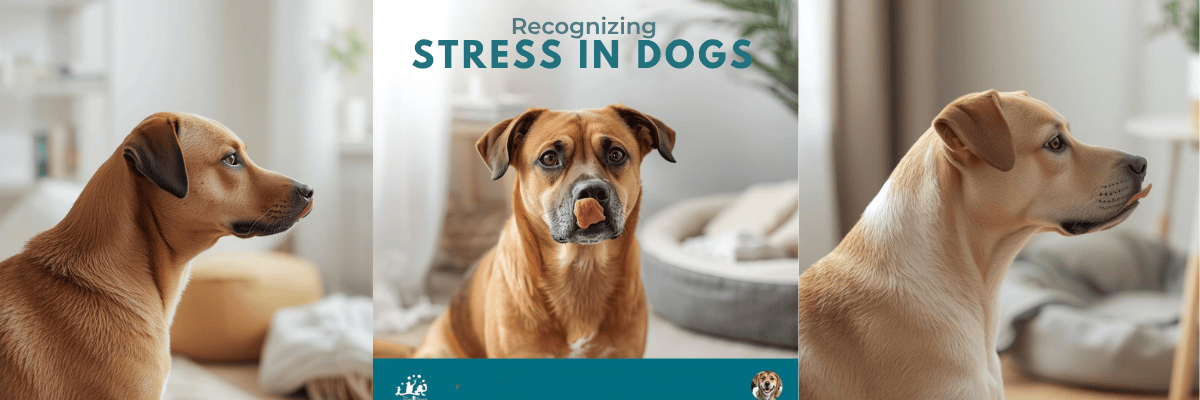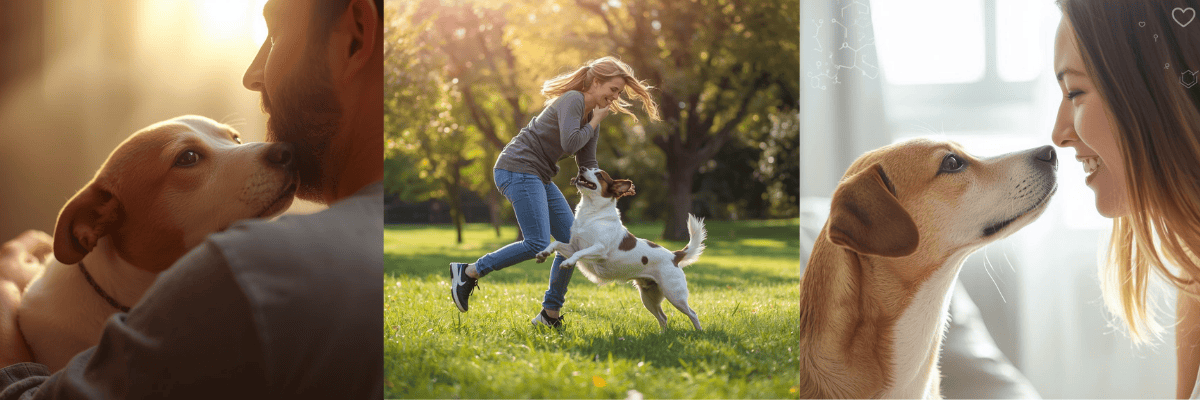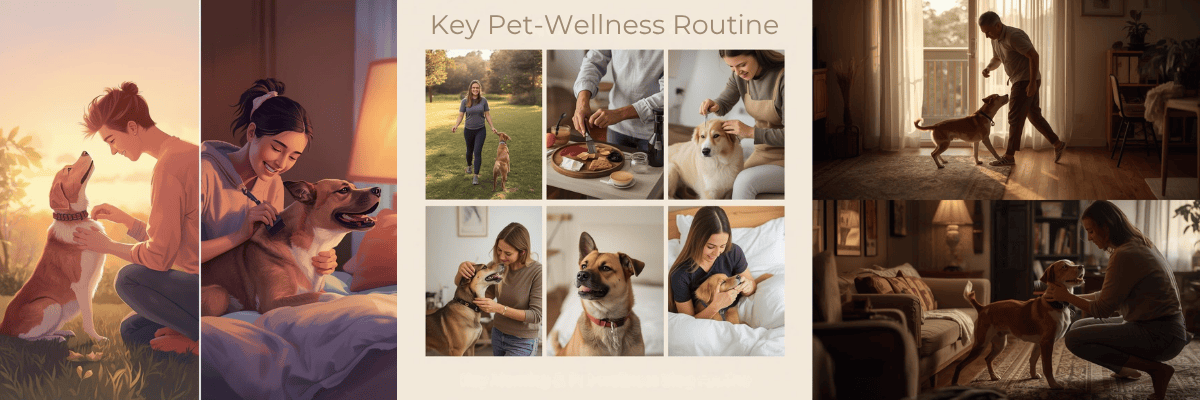Introduction
Dogs, like humans, experience stress in response to changes, challenges, or threats in their environment. While some stress is temporary and harmless, chronic stress can affect a dog’s behavior, health, and overall well-being.

Recognizing the signs of stress early is crucial for ensuring your dog feels safe, secure, and happy. From subtle body language cues to more obvious behavioral changes, dogs communicate their discomfort in ways that attentive owners can learn to understand.
In this post, we’ll explore the physical and behavioral signs of stress in dogs, common triggers, and effective ways to respond and prevent stress, helping you strengthen your bond and support your dog’s health and happiness.
Understanding Stress in Dogs
Stress in dogs is a natural response to physical, mental, or emotional challenges. It occurs when a dog perceives a situation as threatening, overwhelming, or unpredictable. While short-term stress can be harmless or even helpful in preparing a dog to respond to a challenge, chronic stress can lead to serious health and behavioral problems.

Common Causes of Stress
- Environmental changes: moving homes, rearranged furniture, or changes in routine.
- Social interactions: meeting new people, animals, or exposure to dominant dogs.
- Health issues: pain, illness, or aging-related discomfort.
- Loud noises: thunderstorms, fireworks, or construction.
Short-Term vs. Chronic Stress
- Short-term stress: brief, situational, usually resolves on its own (e.g., a car ride).
- Chronic stress: prolonged, persistent, can weaken the immune system, cause anxiety, and contribute to destructive or aggressive behavior.
Understanding the sources and types of stress is the first step in recognizing and addressing it, allowing you to support your dog effectively.
Common Physical Signs of Stress
Dogs often show stress through their bodies before it becomes apparent in their behavior. Recognizing these physical signs can help you intervene early and prevent more serious issues.

Panting, Drooling, or Trembling
- Excessive panting or drooling, even when not hot or after exercise, can indicate stress.
- Trembling or shaking may appear when a dog feels anxious or threatened.
Pacing or Restlessness
- A stressed dog may pace, circle, or move continuously, showing they are unable to relax.
Changes in Appetite or Bathroom Habits
- Stress can lead to loss of appetite, overeating, or sudden accidents in the house.
Dilated Pupils and Yawning
- Dilated pupils or frequent yawning are subtle stress indicators.
- Yawning in stressful contexts is often a displacement behavior signaling anxiety.
By observing these physical signs alongside other behaviors, you can better identify when your dog is experiencing stress and take steps to alleviate it.
Behavioral Signs of Stress
In addition to physical signs, stressed dogs often display noticeable changes in behavior. Paying attention to these cues helps you respond appropriately and support your dog’s well-being.

Excessive Barking or Whining
- Dogs may vocalize more when anxious, seeking attention or signaling discomfort.
Hiding or Avoiding Interaction
- A stressed dog might retreat to a safe space or avoid people and other pets.
Aggression or Irritability
- Sudden growling, snapping, or other aggressive behavior can indicate fear or frustration.
Licking, Chewing, or Destructive Behavior
- Stress may lead to compulsive behaviors, such as chewing furniture, scratching doors, or excessive licking.
By recognizing these behavioral changes early, you can address the underlying cause of stress and prevent escalation.
Subtle Signs Often Overlooked
Some signs of stress in dogs are subtle and easily missed, yet they can provide important clues about your dog’s emotional state.

Lip Licking, Yawning, or Sneezing
- These are displacement behaviors—actions dogs perform when feeling anxious or conflicted.
- Frequent yawning or licking in non-tiring situations often signals stress.
Tail Position and Body Posture Changes
- A low or tucked tail indicates fear or submission.
- A stiff or raised tail may signal tension or alertness.
Changes in Energy Levels or Sleep Patterns
- Stressed dogs may sleep more to cope or become unusually hyperactive.
- Sudden lethargy or restlessness can be a warning sign.
Noticing these subtle cues allows you to intervene before stress escalates into more serious behavioral or health problems.
Situational Stress Triggers
Stress in dogs often arises from specific situations or environmental changes. Recognizing common triggers helps you anticipate and prevent anxiety.

Visitors or New People
- Dogs may feel uneasy around strangers or new household members.
- Some may hide, bark excessively, or become overly excited.
Loud Noises
- Thunderstorms, fireworks, and construction sounds can cause anxiety.
- Noise phobia may manifest as shaking, panting, or destructive behavior.
Travel or Car Rides
- Many dogs experience stress during trips, especially if they’re not accustomed to car rides.
- Signs include drooling, pacing, or whining.
Veterinary Visits or Grooming Sessions
- Unfamiliar environments, handling, or medical procedures can trigger stress.
- Dogs may resist, vocalize, or exhibit fear-based behaviors.
Understanding these situational triggers allows you to prepare, comfort, and desensitize your dog, reducing stress and promoting confidence.
How to Respond to a Stressed Dog
Once you recognize signs of stress, knowing how to respond appropriately is key to helping your dog feel safe and calm.

Create a Safe, Calm Environment
- Provide a quiet space away from loud noises or busy areas.
- Offer a cozy bed, crate, or safe corner where your dog can retreat.
Use Positive Reinforcement and Reassurance
- Reward calm behavior with treats, praise, or gentle petting.
- Speak in a soothing, calm voice to reduce anxiety.
Avoid Punishment or Forcing Interaction
- Never scold or force a stressed dog to interact, as this can increase fear.
- Allow your dog to approach on their own terms.
Seek Professional Help When Needed
- If stress persists or leads to aggression, consult a veterinarian or professional dog trainer/behaviorist.
- Persistent stress may indicate underlying health or behavioral issues that need attention.
By responding thoughtfully, you can help your dog feel secure and gradually reduce stress over time.
Preventing Stress in Dogs
Prevention is often easier than managing stress once it occurs. By proactively creating a supportive environment, you can minimize your dog’s stress levels.

Establish a Predictable Routine
- Consistent feeding, walking, and play schedules help dogs feel secure.
- Sudden changes in routine can trigger anxiety.
Provide Mental and Physical Stimulation
- Regular exercise, interactive toys, and training exercises keep your dog engaged.
- Mental stimulation reduces boredom-related stress and destructive behaviors.
Socialization Strategies
- Gradually expose puppies and adult dogs to new people, animals, and environments.
- Positive experiences during socialization help prevent fear-based stress later.
Environmental Enrichment and Safe Spaces
- Offer cozy resting areas, puzzle toys, and quiet zones in the home.
- Providing choice and control over their environment empowers your dog and reduces anxiety.
By implementing these strategies, you create a stress-resilient environment that promotes happiness, health, and confidence in your dog.
Conclusion
Stress is a natural part of life for dogs, but recognizing it early can make a big difference in their health, behavior, and overall well-being. From obvious signs like panting and pacing to subtle cues such as lip licking, yawning, or changes in posture, attentive observation is key.

By understanding common triggers, reading physical and behavioral signals, and responding appropriately, you can help your dog feel safe, secure, and confident. Prevention through routine, enrichment, and socialization further strengthens your dog’s resilience to stress, ensuring a happier, healthier, and more balanced life.
Being mindful of your dog’s emotional state not only improves their quality of life but also deepens the bond you share.




Leave a Reply